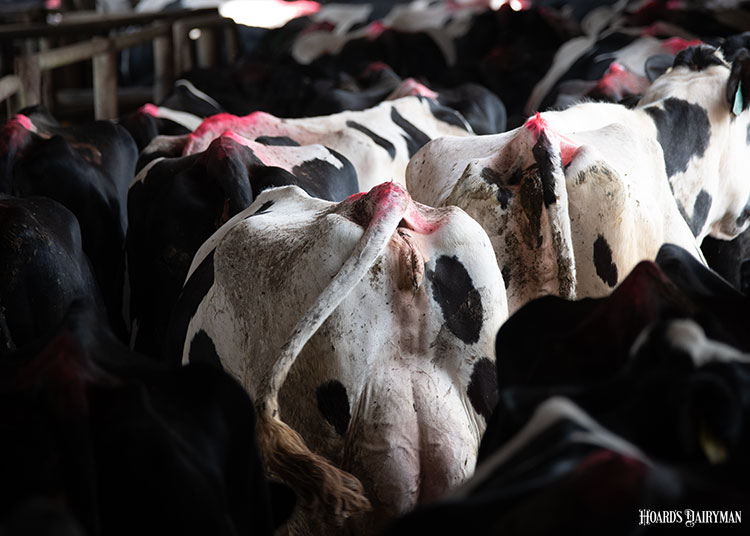
A sense of frustration floods in when you see a cow around 29 days post-breeding being mounted. After getting through the 21-day window, there is a brief moment of comfort until you now realize something must have gone wrong.
Typically, pregnancy loss happens to 1 in 5 cows in the dairy herd. Early embryo death results in financial losses felt through longer days open and cows that fail to get pregnant again. While there has been great improvement in pregnancy rate over the last 20 years, there are still struggles to get and keep cows pregnant. Dairy Records Management System (DRMS) reports the number of services per pregnancy averages 2.9 for U.S. Holsteins on test.
How can someone predict, or more importantly, prevent pregnancy loss in the herd? Tony Bruinjé and Stephen LeBlanc’s team from the University of Guelph worked with two well-managed Canadian commercial Holstein herds to help quantify the impact of uterine health on failed pregnancy. Cows were closely monitored from three weeks prior to calving through 40 days following insemination to determine if they experienced endometritis, metritis, or purulent vaginal discharge and track pregnancy from day 19 to day 40. The results of their project were recently published in the Journal of Dairy Science and featured on the “Dairy Science Digest” podcast.
Pregnancy loss is common
Even healthy cows that sail through the transition period still experience embryo loss. “Sperm meets egg and forms an embryo most of the time,” described LeBlanc, a professor and the director of Dairy at Guelph, the university’s center for dairy research. “Seventy-one percent of healthy cows were pregnant 19 days after insemination, but only 49% maintained that pregnancy by day 40.”
While this is not new news, it is still challenging that even seemingly healthy cows struggle to maintain pregnancy to 40 days. The problem of pregnancy loss is substantially greater in cows that lived through uterine disease, even though they seemingly recovered.
One-two punch of metritis
Fertility is reduced when transition trouble strikes. LeBlanc described the failure as a “one-two punch”: first with failed conception, followed by greater embryo death that is most common in cows experiencing uterine disease.
Researchers found clinical and even subclinical uterine disease through the transition period resulted in reduced pregnancy per A.I. when compared to healthy counterparts.
- Uterine disease resulted in significantly less pregnancy 19 days after insemination (71% versus 54%)
- Cows with uterine disease lost more embryos by day 40 than those healthy through transition (49% versus 31%)
- Cows experiencing more than one clinical disease were significantly less likely to maintain pregnancy (47% vs 19%)
Causes of early loss
The team was interested in understanding the relationship of uterine health to the observed losses. One would think that a chronic, low grade, smoldering uterine inflammation might not be a friendly location for a tiny embryo to flourish. And while that’s true, previous work out of Florida suggests that the reduced fertility is likely a result of ovarian change more than an effect on the uterus.
The eggs, or oocytes, on the ovary are being developed months in advance. So, when exposed to the inflammation of metritis or endometritis, these oocytes become damaged. As a result, the damaged egg may conceive, but it may not be able to continue to develop beyond 40 days. This is referred to as the “hangover effect,” which lasts for at least three months.
As a result, LeBlanc reminded dairy farmers that what happens in the transition pen doesn’t just end there. When a fresh cow is treated and recovers from the clinical disease, it’s tempting to just turn the page and forget about it.
“However, the cow is still on the page that was written for her through transition as she enters the breeding period. We can’t undo or fix damage done during that time,” he described.
How can your farm’s transition cow management help your herd write a new story of fertility success in the next lactation? While we aren’t going to be able to prevent every problem, each problem we do prevent has a long-term payback not only in the value of milk or avoided inconvenience but also in longer-term effects on fertility. To improve fertility metrics from good to great in your herd, begin in the transition pen.
These findings were reported in the peer-reviewed open access Journal of Dairy Science available at: www.journalofdairyscience.org. To learn more, listen in to the monthly podcast, "Dairy Science Digest" on your favorite podcast platform.








